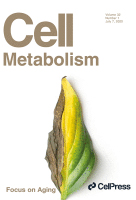Cell Metab. 2020 Jul 7;32(1):87-99.e6. doi: 10.1016/j.cmet.2020.05.002. Epub 2020 Jun 1.
Laurent Grosse 1 , Nicole Wagner 2 , Alexander Emelyanov 1 , Clement Molina 1 , Sandra Lacas-Gervais 3 , Kay-Dietrich Wagner 2 , Dmitry V Bulavin 4
Affiliations
1 Institute for Research on Cancer and Aging of Nice (IRCAN), INSERM, Université Côte d’Azur, Centre National de la Recherche Scientifique (CNRS), Nice, France.
2 Université Côte d’Azur, INSERM, Centre National de la Recherche Scientifique (CNRS), Institute of Biology Valrose, Nice, France.
3 Electron Microscopy Facility, Centre Commun de Microscopie Appliquée, CCMA, Université Côte d’Azur, UCA, Nice, France.
4 Institute for Research on Cancer and Aging of Nice (IRCAN), INSERM, Université Côte d’Azur, Centre National de la Recherche Scientifique (CNRS), Nice, France. Electronic address: dmitry.bulavin@unice.fr.
Abstract
The accumulation of senescent cells can drive many age-associated phenotypes and pathologies. Consequently, it has been proposed that removing senescent cells might extend lifespan. Here, we generated two knockin mouse models targeting the best-characterized marker of senescence, p16Ink4a. Using a genetic lineage tracing approach, we found that age-induced p16High senescence is a slow process that manifests around 10-12 months of age. The majority of p16High cells were vascular endothelial cells mostly in liver sinusoids (LSECs), and to lesser extent macrophages and adipocytes. In turn, continuous or acute elimination of p16High senescent cells disrupted blood-tissue barriers with subsequent liver and perivascular tissue fibrosis and health deterioration. Our data show that senescent LSECs are not replaced after removal and have important structural and functional roles in the aging organism. In turn, delaying senescence or replacement of senescent LSECs could represent a powerful tool in slowing down aging.
PMID: 32485135
DOI: 10.1016/j.cmet.2020.05.002

